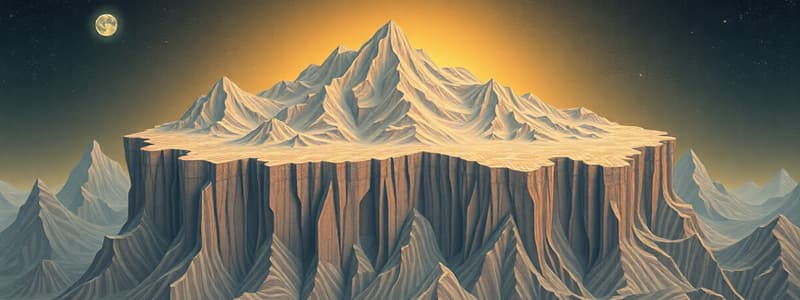Podcast
Questions and Answers
What type of geological activity is primarily associated with divergent plate boundaries?
What type of geological activity is primarily associated with divergent plate boundaries?
- Subduction leading to oceanic trenches
- Formation of large mountain ranges
- Mountain formation through continental collision
- Creation of volcanic activity and earthquakes (correct)
Which feature is commonly formed as a result of convergent plate boundaries?
Which feature is commonly formed as a result of convergent plate boundaries?
- Oceanic ridges
- Mid-ocean rifts
- Subduction zones (correct)
- Volcanic islands
What describes the motion of plates at transform plate boundaries?
What describes the motion of plates at transform plate boundaries?
- Plates separate and generate new crust
- Plates move towards each other leading to volcanic activity
- Plates slide past one another horizontally (correct)
- Plates collide and create mountains
What phenomenon occurs without subduction according to plate tectonic theory?
What phenomenon occurs without subduction according to plate tectonic theory?
What process is responsible for the generation of new crust at divergent boundaries?
What process is responsible for the generation of new crust at divergent boundaries?
Which statement accurately describes an outcome of convergent plate boundaries?
Which statement accurately describes an outcome of convergent plate boundaries?
What is a characteristic of oceanic trenches formed by convergent plate boundaries?
What is a characteristic of oceanic trenches formed by convergent plate boundaries?
What type of movement occurs at divergent plate boundaries?
What type of movement occurs at divergent plate boundaries?
Flashcards are hidden until you start studying
Study Notes
Divergent Plate Boundaries
- Also known as constructive or extensional plate boundaries.
- New crust is generated, for example, the mid-Atlantic Rift.
- Upwelling magma is ejected at the surface, creating new crust.
- As the newly-formed basalt cools, it adds to the plates.
- Often creates a zone with many volcanoes and earthquakes.
- Leads to subduction zones where the denser oceanic crust slides beneath the lighter continental crust.
Convergent Plate Boundaries
- Where two plates move towards each other.
- Also called destructive plate boundaries.
- May lead to the formation of mountains either by physically pushing up the continental crust by the pressure of the colliding plates or by the melting and buoyant rise of less dense rock material generated during subduction.
- Subduction zones are also being considered as possible disposal sites for nuclear waste.
- Rock closest to the boundary is younger than rock further away on the same plate.
- Initially produce rifts which produce rift valleys if occur on continents.
- Convection in the mantle causes material to rise to the base of the plate boundary, supplying heat & reducing pressure that melts rock beneath the rift area, filling the gap left when they part.
- Continental collisions in which the colliding plate material is of similar density may also cause mountain-building.
- Subduction causes oceanic trenches, such as the Mariana trench, where one plate begins its descent beneath another.
- Without subduction, plate tectonics could not exist. Earth's crust would not have split into continents. Oceans and all of the solid Earth would lie beneath a global ocean.
Transform Plate Boundaries
- Also known as fault/ strike-slip/sliding/ conservative plate boundary.
- The plates slide past each other horizontally.
- Most exist between oceanic plates, causing oceanic rifts.
- During collisions between two continental plates, large mountain ranges, such as the Himalayas are formed.
- The San Andreas Fault is a famous example of a transform plate boundary.
- Most are locked in tension before suddenly releasing, sliding and causing earthquakes.
Studying That Suits You
Use AI to generate personalized quizzes and flashcards to suit your learning preferences.




